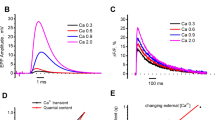Abstract
The actions of lead (Pb2+) on transmitter release were studied at neuromuscular junctions in mouse diaphragm in vitro. The quantal content of end-plate potentials (EPPs) was reduced by Pb2+ in a dose-related manner consistent with inhibition of Ca2+ entry into nerve terminals, with a half-maximal effect at 1.4 μM (in 0.5 mM Ca2+ and 2 mM Mg2+). Pb2+ also inhibited the increased frequency of MEPPs (f MEPP where MEPPs denotes miniature EPPs) produced by Ba2+ in the presence of raised K+, blocking the calculated Ba2+ entry half-maximally at 170 μM. However, at concentrations of 50–200 nM, Pb2+ often increased f MEPP in 20 mM K+ in the presence of Ca2+ and acted to promote the irreversible effect of lanthanum (La3+) to raise f MEPP. In nominally Ca2+-free solution with 20 mM K+, brief (1 min) application of Pb2+ (20–320 μM) caused rapid dose-dependent reversible rises in f MEPP. With prolonged exposure to Pb2+,f MEPP rose and then slowly declined; after removal of Pb2+, once f MEPP had fallen to low levels, f MEPP responded nearly normally to Ca2+ or ethanol, but not to Pb2+ itself. In 5 mM K+, 0 mM Ca2+ and varied [Pb2+] (where [ ] denotes concentration), nerve stimulation caused no EPPs, but prolonged tetanic stimulation produced increases in f MEPP graded with [Pb2+] that persisted as a “tail”; results were consistent with growth f MEPP with the 4th power of intracellular Pb2+ and removal of intracellular Pb2+ with a time constant of about 30 s. These results suggest that Pb2+ acts to block the entry of Ca2+ and Ba2+ into the terminal via voltage-gated Ca2+ channels through which Pb2+, at higher concentrations, also penetrates and then acts as an agonist at intracellular sites that govern transmitter release.
Similar content being viewed by others
References
Anwyl R, Kelly T, Sweeney F (1982) Alterations of spontaneous quantal transmitter release at mammalian neuromuscular junction induced by divalent and trivalent ions. Brain Res 246:127–132
Atchison W, Narahashi T (1984) Mechanism of action of lead on neuromuscular junctions. Neurotoxicology 5:267–282
Balnave RJ, Gage PW (1973) The inhibitory effect of manganese on transmitter release at the neuromuscular junction of the toad. Br J Pharmacol 47:339–352
Cooke JD, Quastel DMJ (1973) Transmitter release by mammalian motor nerve terminals in response to focal polarization. J Physiol (Lond) 228:377–405
Cooper GP, Suszkiw JB, Manalis RS (1984) Heavy metals: effects on synaptic transmission. Neurotoxicology 5:247–266
Curtis MJ, Quastel DMJ, Saint DA (1986) Lanthanum as a surrogate for calcium in transmitter release at the neuromuscular junction. J Physiol (Lond) 373:243–260
Dudel J (1989) Calcium and depolarization dependence of twin pulse facilitation of synaptic release at nerve terminals of crayfish and frog muscle. Pflügers Arch 415:304–309
Gage PW, Quastel DMJ (1966) Competition between sodium and calcium ions in transmitter release at mammalian neuromuscular junctions. J Physiol (Lond) 185:95–123
Guan YY, Quastel DMJ, Saint DA (1987) Multiple actions of cadmium on transmitter release at the mouse neuromuscular junction. Can J Physiol Pharmacol 65:2131–2136
Guan YY, Quastel DMJ, Saint DA (1988) Single Ca2+ entry and transmitter release systems at the neuromuscular synapse. Synapse 2:558–564
Hess P, Tsien RW (1984) Mechanism of ion permeation through calcium channels. Nature 309:453–456
Lin-Shiau SY, Fu WP (1980) Effects of divalent cations on neuromuscular transmission in the chick. Eur J Pharmacol 64:259–269
Manalis RS, Cooper GP, Pomeroy L (1984) Effects of lead on neuromuscular transmission in the frog. Brain Res 294:95–109
Nishimura M (1987) Zinc competitively inhibits calcium-dependent release of transmitter at the mouse neuromuscular junction. Pflügers Arch 410:623–626
Nishimura M (1988) Zn2+ stimulates spontaneous transmitter release at mouse neuromuscular junctions. Br J Pharmacol 93:430–436
Quastel DMJ, Saint DA (1986) Calcium cooperativity in calcium entry and calcium action, and its implications with regard to facilitation, at the mouse motor nerve terminal. In: Rahamimoff R, Katz B (eds) Calcium, neuronal function and transmitter release. Martinus Nijhoff, Boston, p 141
Quastel DMJ, Saint DA (1988) Transmitter release at mouse motor nerve terminals mediated by temporary accumulation of intracellular barium. J Physiol (Lond) 406:55–73
Quastel DMJ, Hackett JT, Cooke JD (1971) Calcium: Is it required for transmitter secretion? Science 172:1034–1036
Saint DA, McLarnon JG, Quastel DMJ (1987) Anion permeability of motor nerve terminals. Pflügers Arch 409:258–264
Silbergeld EK, Fales JT, Goldberg AM (1974) The effect of inorganic lead on the neuromuscular junction. Neuropharmacology 13:795–801
Silen L, Martell AE (1971) Stability constants. The Chemical Society, special publication 25 [suppl 1], London, p 623
Silinski EM (1985) The biophysical pharmacology of calcium-dependent acetylcholine secretion. Pharmacol Rev 37:81–132
Wang YX, Quastel DMJ (1990) Multiple actions of zinc on transmitter release at mouse end-plates. Pflügers Arch 415:582–587
Weakly JN (1973) The action of cobalt ion on neuromuscular transmission in the frog. J Physiol (Lond) 234:597–612
Zengel JE, Lee DT, Van Veelen ML, Moser DR (1988) Effects of divalent cations on stimulation-induced changes in transmitter release at the frog neuromuscular junction (abstract). Biophys J 53:363
Author information
Authors and Affiliations
Rights and permissions
About this article
Cite this article
Wang, YX., Quastel, D.M.J. Actions of lead on transmitter release at mouse motor nerve terminals. Pflügers Arch. 419, 274–280 (1991). https://doi.org/10.1007/BF00371107
Received:
Revised:
Accepted:
Issue Date:
DOI: https://doi.org/10.1007/BF00371107



